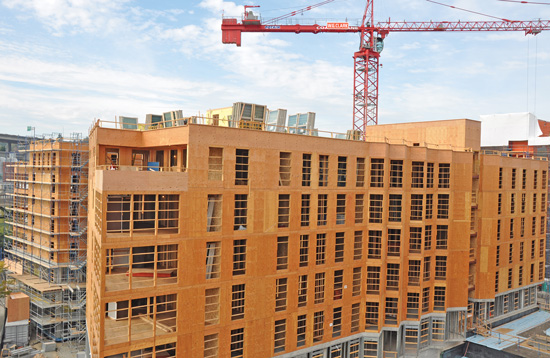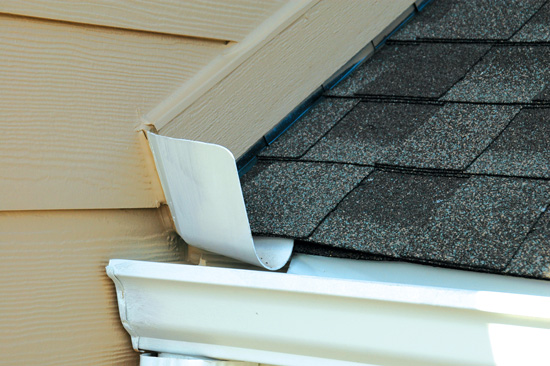Designing for Durability
Natural Moisture Levels in Wood
Wood and water in natural balance are compatible. Wood tolerates high humidity and is capable of absorbing and releasing water vapor without compromising its structural integrity. This moisture buffering effect of wood is called hygroscopicity.

Photo: Ankrom Moisan Architects, WG Clark Construction
For this project in the Pacific Northwest, plywood sheathing is used as an exterior substrate, onto which the weather-resistant barrier and cladding would be attached.
Although problems may arise when wood gets wet for too long, wood buildings that are properly designed and constructed perform well in all types of climates. “All materials have challenges when it comes to moisture; however, when moisture is managed properly, wood buildings perform well even in the wettest parts of the country,” says Ethan Martin, P.E., regional director for WoodWorks in the Pacific Northwest.
Moisture content (MC) is a measure of how much water is in a piece of wood relative to the wood itself. It is expressed as a percentage calculated by dividing the weight of water in the wood by the weight of that wood if it were oven dry. For example, 100 percent MC signifies that a piece of lumber has the same amount of water, in weight, as it does wood.
Two important MC numbers to remember are 19 percent and 28 percent. A piece of solid sawn lumber or timber is considered dry for structural applications if it has an MC of 19 percent or less. Fiber saturation averages around 28 percent.
Fiber saturation is important because it is the point at which cell walls are holding as much water as they can. If more water is introduced, it will go to the cell cavity. Research by FPInnovations, a non-profit forest research center, has shown that, at a temperature of approximately 68 degrees Fahrenheit, decay fungi can colonize kiln-dried wood products when the MC rises to a threshold of 26 percent.5 It’s not the water per se that harms wood, but a consistently elevated moisture content that allows fungi to proliferate.
The fiber saturation point is also the limit for wood shrinkage. As the MC changes, wood shrinks or swells, but only according to the variation of water in the cell walls, not the cell cavity, meaning that wood only shrinks and swells when it changes moisture content below the point of fiber saturation, or 28 percent. Below 28 percent, wood expands as it absorbs moisture and contracts as it dries. Shrinkage and expansion is largest in the direction around the growth rings (tangential) and is also significant across growth rings (radial). Consequently, the width and depth of sawn lumber (e.g., across the depth of plates and band or rim joists) shrink the most. Shrinkage in the longitudinal direction, such as along the length of a wall stud, is much less significant.
These naturally occurring movements of wood are not problematic with proper design and construction, yet they are an important consideration for taller wood buildings of five stories or more. The rule of thumb is that, for every 4 percent change in MC below 28 percent, there is approximately 1 percent change in dimension across the growth rings (radial and tangential directions). This means that horizontal solid wood members of buildings, such as plates and joists, have the most effect on building movement. Engineered wood products are dryer from manufacturing and also usually have lower shrinkage coefficients when compared with lumber and solid wood timbers, but they may be more susceptible to water absorption.
Simple construction details, such as ensuring that materials are compatible and leaving gaps between sheathing panels and in cladding between floors, will accommodate shrinkage and swelling. Given an environment with consistent temperature and relative humidity, the moisture content of wood will stabilize—interior wood at 8-14 percent moisture content and exterior wood at 12-18 percent, depending on indoor and outdoor climates.6
The shortest path to trouble-free use of wood in buildings is to begin with dry wood and then prevent excess moisture intrusion during construction and in building service. By starting with dry lumber, some of the shrinkage will have occurred prior to purchase as the MC drops from 28 percent to 19 percent or even lower. Meanwhile, preventing excessive wetting and allowing the wood to dry during construction will greatly reduce the potential for differential movement that may cause serviceability and durability issues in a wood building. Dry lumber will be stamped with the letters S-DRY (surface-dry, meaning that the MC is 19 percent or lower when it is planed or surfaced to the standard lumber dimension) or KD (kiln-dried). Rough-cut lumber is generally dried and then planed. For kiln-dried softwood framing lumber, the MC is typically around 15 percent.

Photo courtesy of Mark Parlee, The Building Consultant
A molded kick-out flashing device efficiently diverts water into the gutter and prevents water intrusion at the roof/wall intersection.









